Xeramtheum said:What is your method of hand pollinating and how do you isolate the actual flowers/pistils from the pollen/anthers?
Zinnias are easy to hand pollinate because the flower parts are relatively large, easily recognizable, and easy to get to. The pollen is produced by fuzzy yellow starfish-shaped florets and it is accepted by thin yellow Y-shaped stigmas that are located at the base of the petals. There are several ways to transfer the pollen from the florets to the petal stigmas. One way is to use a small artist's brush to pick up some pollen on the tip of the brush.
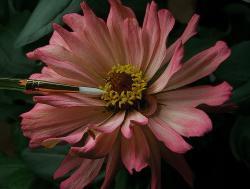
And simply touch the tip of the brush to the stigmas that you want to pollinate.
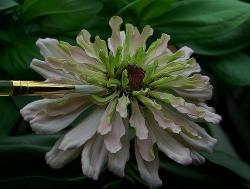
One brush load may carry enough pollen to pollinate several petals (stigmas). Incidentally, each petal/stigma is attached to just one seed. As you know, zinnia seeds are relatively large and easy to handle. Rather than use an artist's brush, you may prefer to use tweezers, twissors, or forceps to pick a whole pollen-bearing floret.
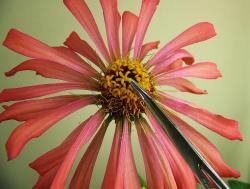
And then, use that fuzzy yellow floret as a pre-loaded "brush" to apply pollen to the target stigmas.
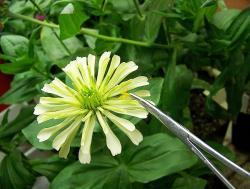
At one time or another, I have used every possible method: forceps, twissors, tweezers, and artist brush. I am currently using a favorite pair of tweezers. I usually don't use any method of protecting the female blossom from further pollination, because I do a fairly thorough job. However, in the event that high-value female blooms open and you aren't ready to pollinate them yet, I do use improvised "hair nets" to protect those blooms from bees and such.
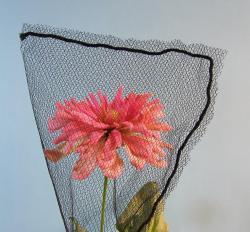
However, that is very rarely necessary. The bees aren't trying to do any pollination -- they are simply gathering pollen and/or nectar and any pollination they do is accidental and incidental. You, on the other hand, are deliberately placing pollen, so you have a very big advantage over the bees. I'll be glad to respond to any further questions you have about this or any zinnia topics.
I really enjoy hybridizing zinnias. When I am doing it I am trying to guess what the results of a cross will be. Zinnias can be full of surprises. And they are easy to grow and easy to breed. And quick to give you results. If you start some a little early indoors and set them in the garden after the danger of frost has passed, you may have time to make some crosses, save some seeds, plant them immediately to get a second crop in time to make crosses between your hybrids and save seeds from those for a really wild second year of zinnias. Whether you have time for a second crop depends on the length of your growing season.
ZM




